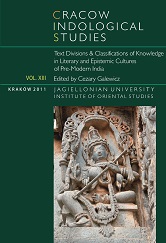Īśvarasaṃhitā or Narasiṃhakalpa on strategies of textual self-representation
Īśvarasaṃhitā or Narasiṃhakalpa on strategies of textual self-representation
Author(s): Ewa Dębicka-BorekSubject(s): Literary Texts
Published by: KSIĘGARNIA AKADEMICKA Sp. z o.o.
Summary/Abstract: In the present article I would like to share some preliminary and cautious observations concerning the way of the self-representation of a hardly known text called either Narasiṃhakalpa or Īśvarasaṃhitā II (ĪS II),1 which despite the absence from the traditional lists of the canonical texts of the tantric school of Vaiṣṇava Pāñcarātra still claims that it is of its origin. My inspiration comes from the colophons of its introductory chapters suggesting that the text forms a part of a well-known saṃhitā of Pāñcarātra, i.e. Īśvarasaṃhitā, whereas, in the course of analyzing its content, not only the interlocutors who transmit and praise its revelation turn out to be not Vaiṣṇavas but Śiva/Īśvara and his consort Pārvatī, but also the revelation itself differs from the one taught in Īśvarasaṃhitā.
Journal: Cracow Indological Studies
- Issue Year: 2011
- Issue No: 13
- Page Range: 83-123
- Page Count: 41
- Language: English

